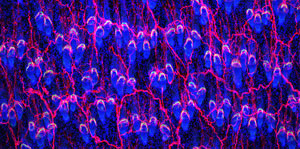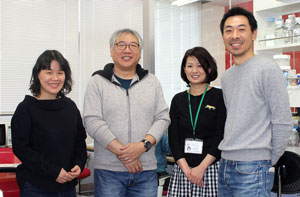Jan. 18, 2019 Research Highlight Biology
Hair follicle stem cells secrete protein that controls the skin’s sense of touch
An extracellular matrix protein secreted by hair follicle stem cells controls the tactile sensation of the skin
 Figure 1: Collar matrices containing EGFL6 (green) connect hair follicles and the skin nerve network (red) with nuclei in skin cells (blue). © 2019 RIKEN Center for Biosystems Dynamics Research
Figure 1: Collar matrices containing EGFL6 (green) connect hair follicles and the skin nerve network (red) with nuclei in skin cells (blue). © 2019 RIKEN Center for Biosystems Dynamics Research
The location of stem cells in the skin that help give mice their sense of touch has been pinpointed by a RIKEN-led team1. This discovery could lead to new treatments for people with sensory processing disorders.
The skin is home to many compartmentalized pools of different stem cells, each with its own properties, location and function. The particular stem cells that help regenerate the hair follicle epidermis are found in a ‘bulge’ about halfway up the outer sheath that surrounds the hair root. And within that bulge are different subregions, each with its own population of stem cells—one of which, it’s now known, produces an extracellular matrix (ECM) protein called EGFL6.
Hironobu Fujiwara, now at the RIKEN Center for Biosystems Dynamics Research, first became interested in this ECM protein while doing a postdoctoral fellowship in the United Kingdom. He found it was concentrated in the extracellular network around the upper part of the bulge. But it was unclear at the time where EGFL6 came from and what it did.
At his RIKEN lab, Fujiwara and his colleagues have now shown that EGFL6 is deposited by stem cells in the upper bulge region itself. Using electron microscopy, the researchers demonstrated that this protein wraps around mechanosensory units found at the hair follicle bulge.
These lanceolate complexes, as they are known, convert tactile cues into nerve signals. EGFL6 and other molecules form a tight sheathe around the complexes, which the researchers dubbed the collar matrix (Fig. 1). Fujiwara’s team showed that the EGFL6-filled collar matrix is needed for the proper parallel patterning of lanceolate complexes and their touch responses in mice.
 Hironobu Fujiwara (far right) and his team have found that hair follicle epidermal stem cells in the upper bulge region deposit the extracellular matrix protein EGFL6, which plays a key role in tactile sensation. © 2019 RIKEN
Hironobu Fujiwara (far right) and his team have found that hair follicle epidermal stem cells in the upper bulge region deposit the extracellular matrix protein EGFL6, which plays a key role in tactile sensation. © 2019 RIKEN
Fujiwara likens the role of the collar matrix to that of a cylinder in a car engine. Just as the cylinder supports the piston, so too the collar matrix is “very important for supporting the parallel nerve-ending structure of the lanceolate complexes,” he says. “EGFL6 helps detect small distortions between the nerve cell surface and the surrounding collar matrix that is generated by skin indentation or hair shaft vibration,” Fujiwara explains.
The next exciting challenge is to determine whether the collar matrix components function as a protein tether that transmit mechanical stimuli to axonal endings by linking them with their surroundings. “Many researchers have been searching for a protein tether for tactile sensation,” says Fujiwara. “The collar matrix has emerged as a major candidate for it.”
The finding could be good news for people suffering from itching and other sensory processing disorders. “Upper-bulge stem cells and the collar matrix may be key elements to restore the sense of touch or cure tactile sensory disorders and itching,” notes Fujiwara.
Related contents
References
- 1. Cheng, C.-C., Tsutsui, K., Taguchi, T., Sanzen, N., Nakagawa, A., Kakiguchi, K., Yonemura, S., Tanegashima, C., Keeley, S. D., Kiyonari, H. et al. Hair follicle epidermal stem cells define a niche for tactile sensation. eLIFE 7, e38883 (2018). doi: 10.7554/eLife.38883
